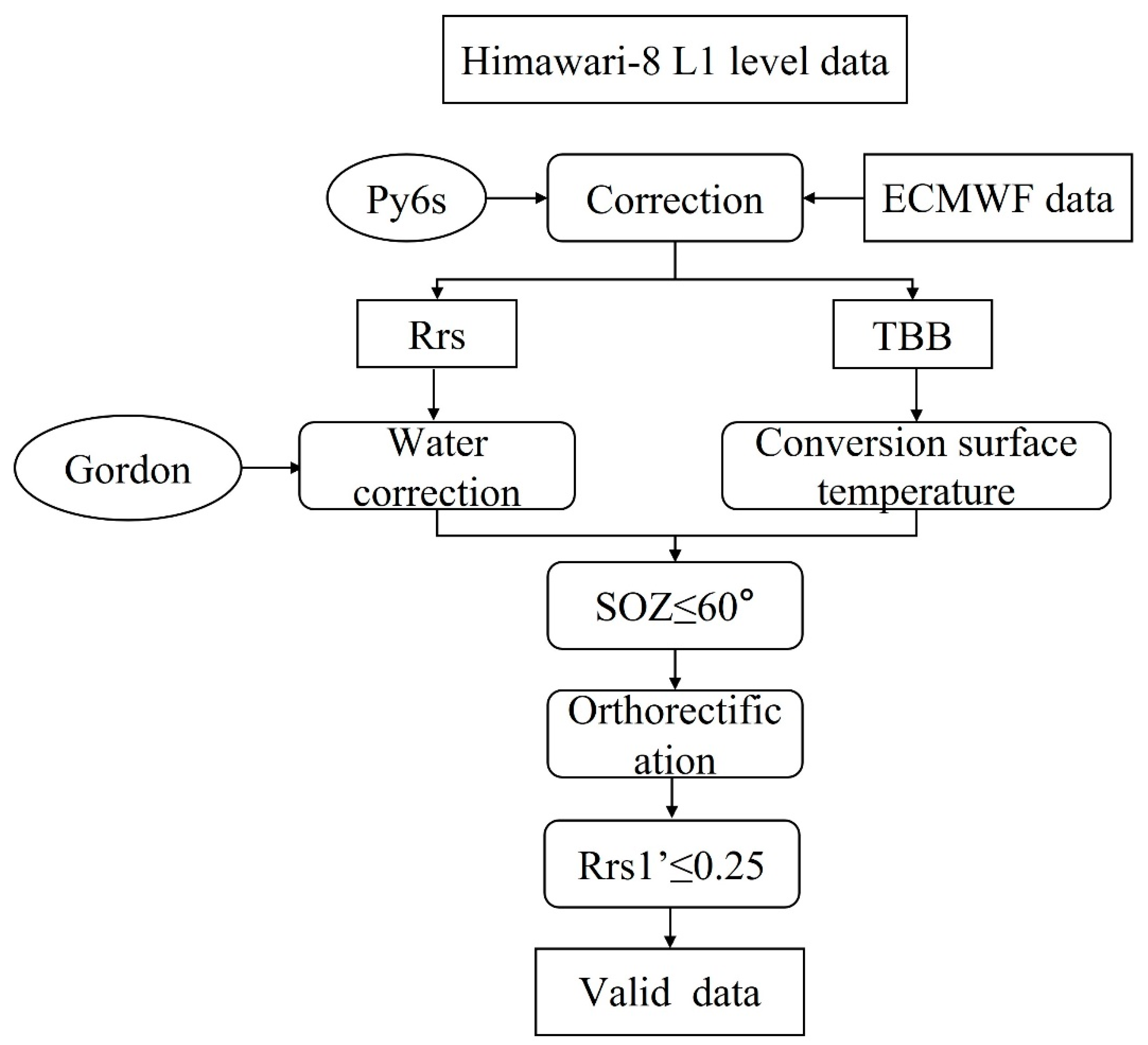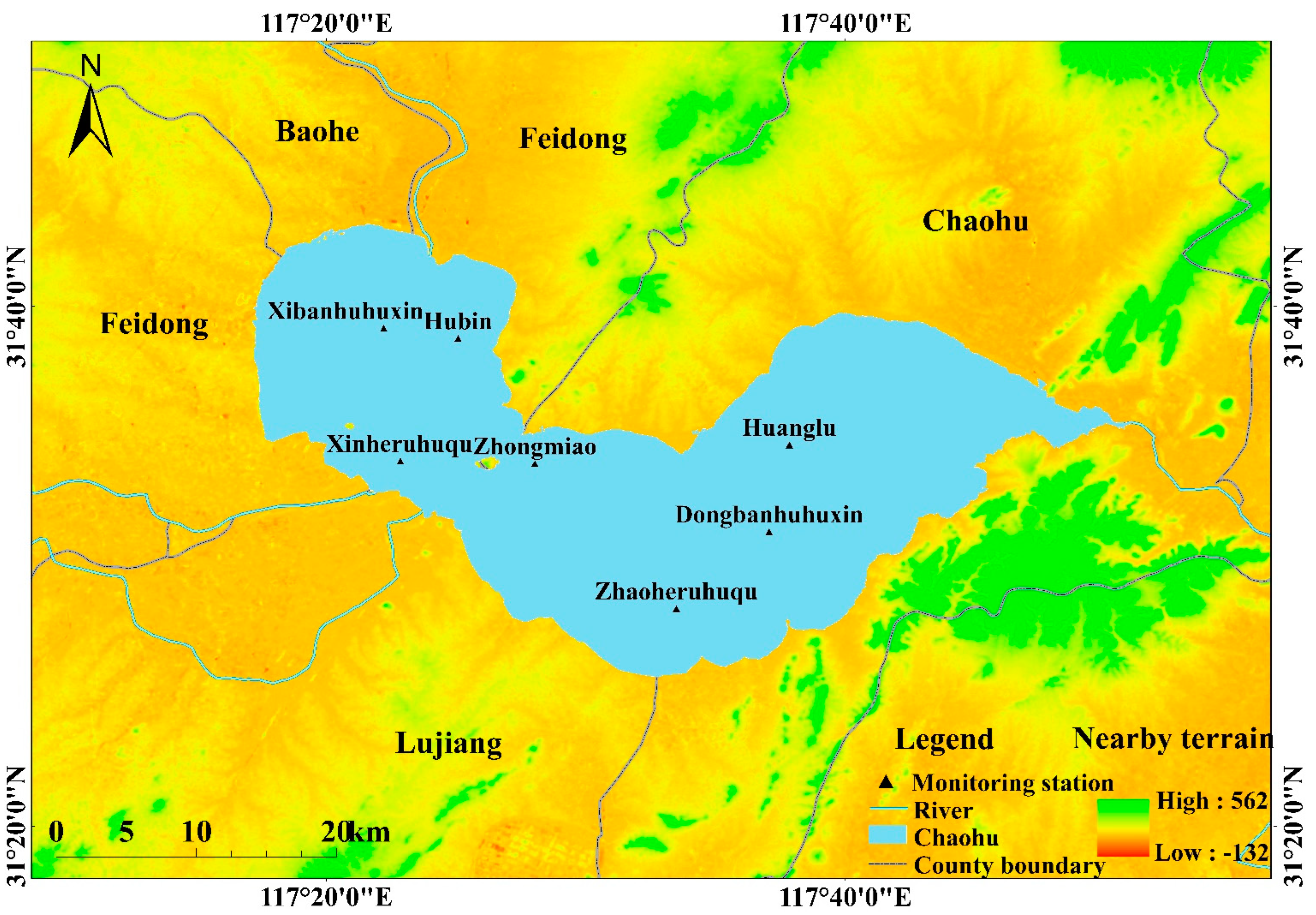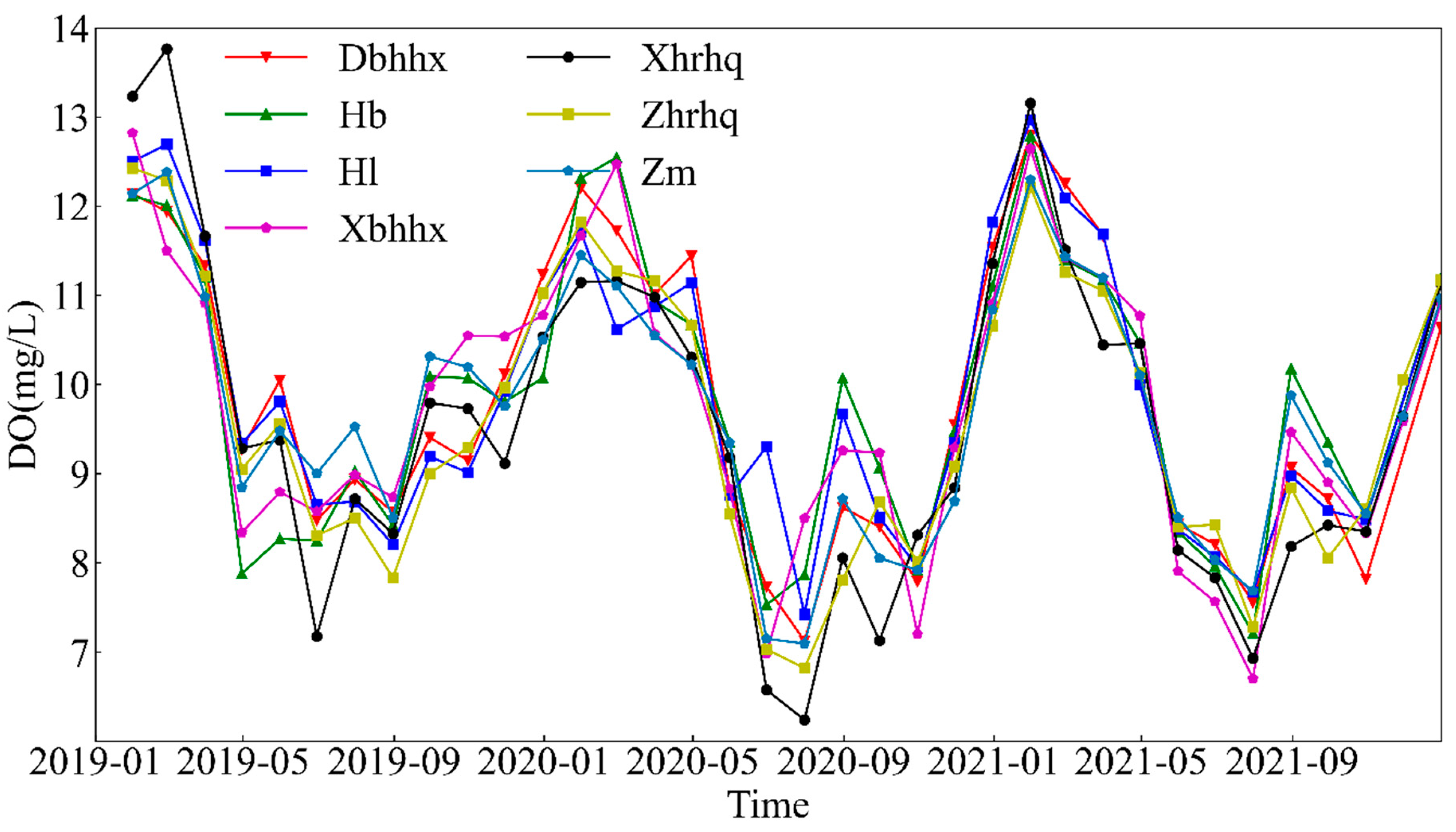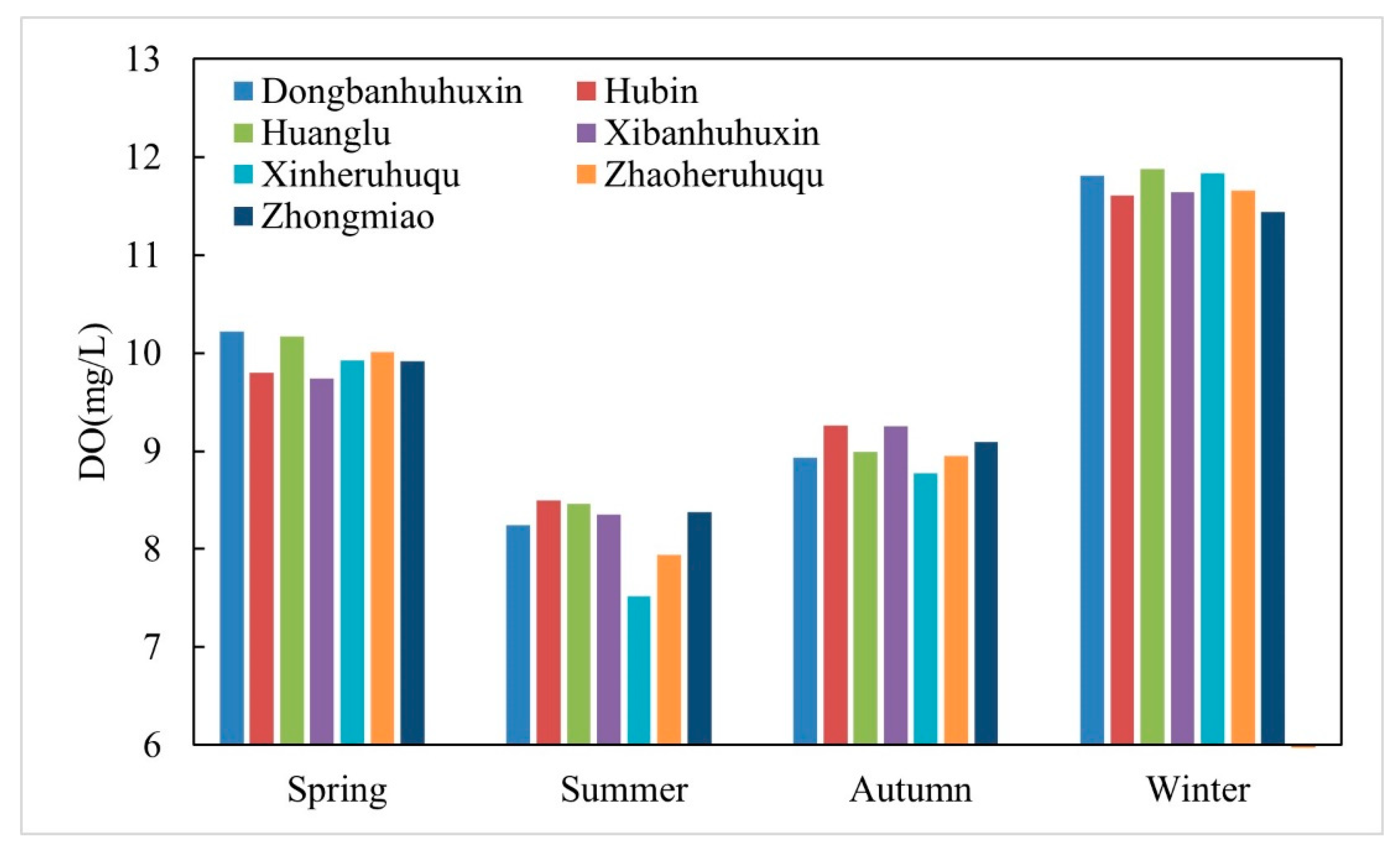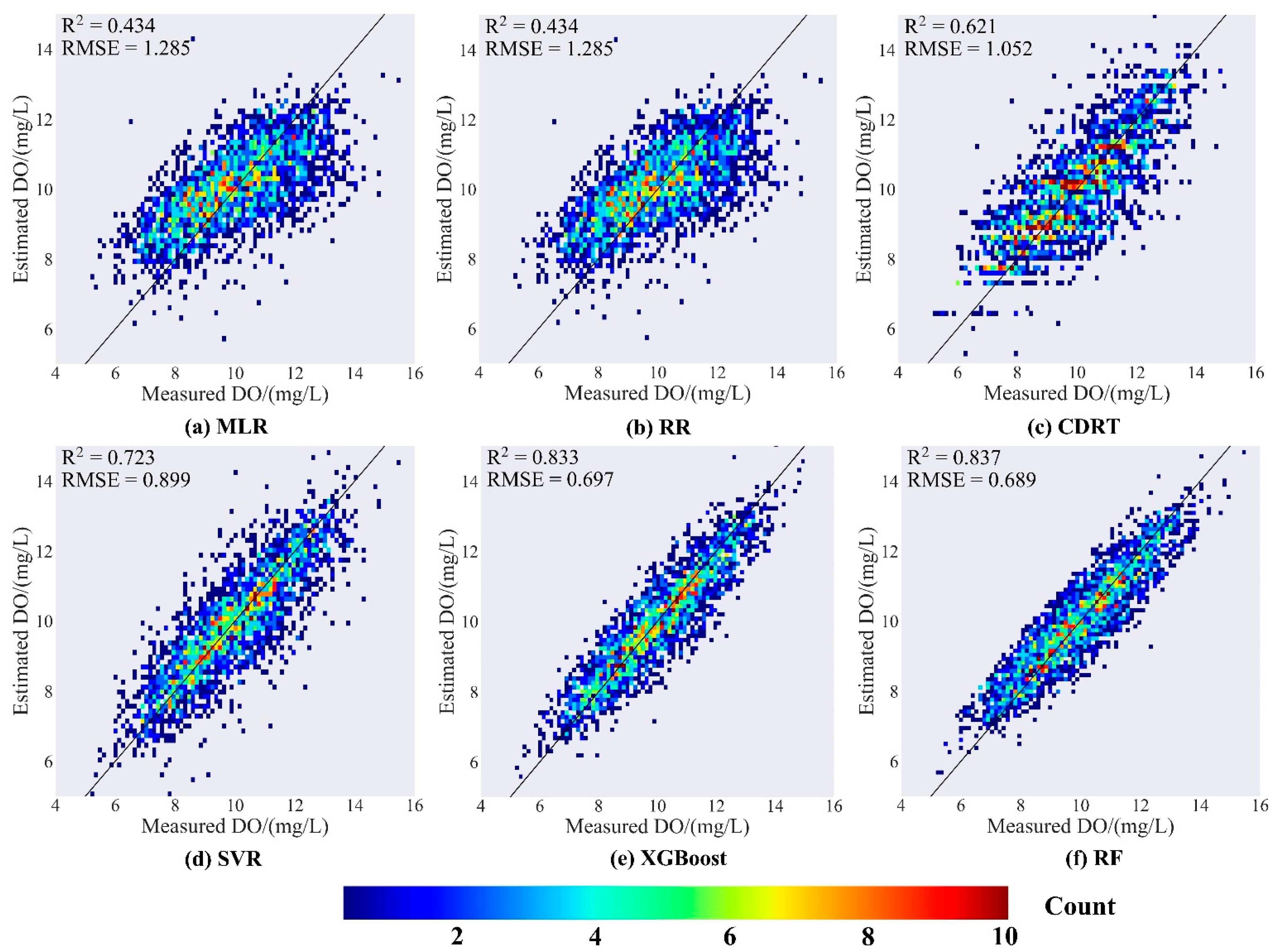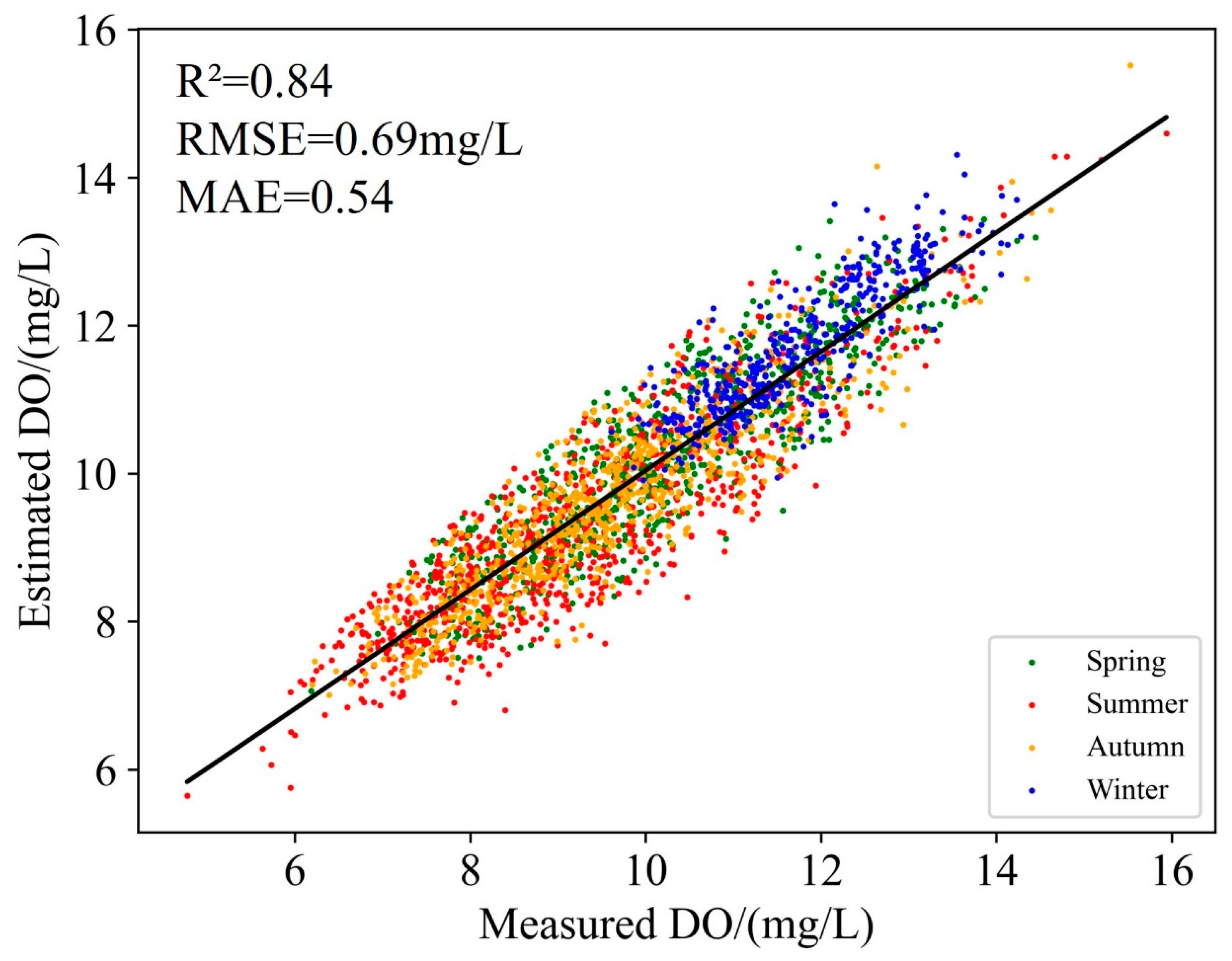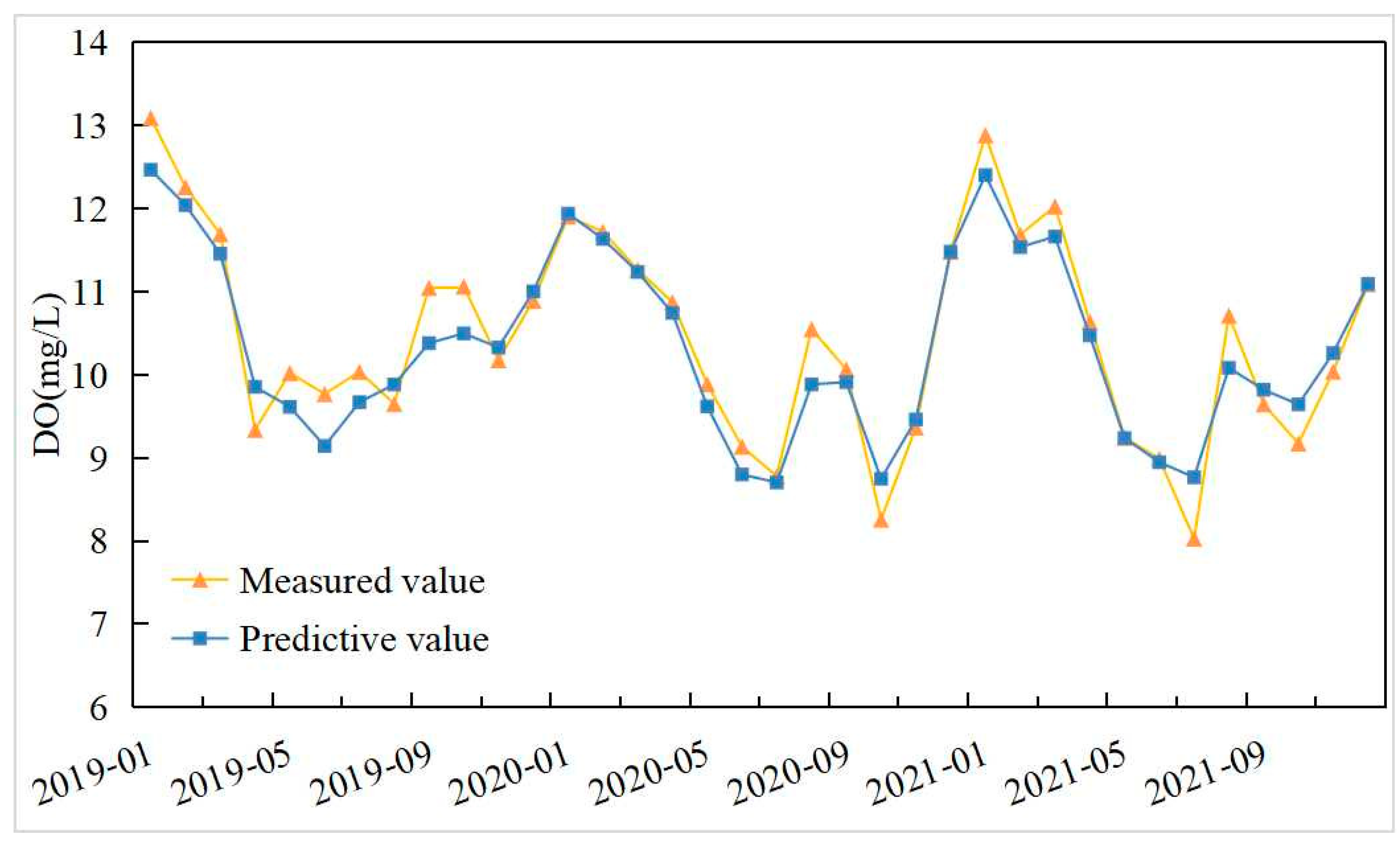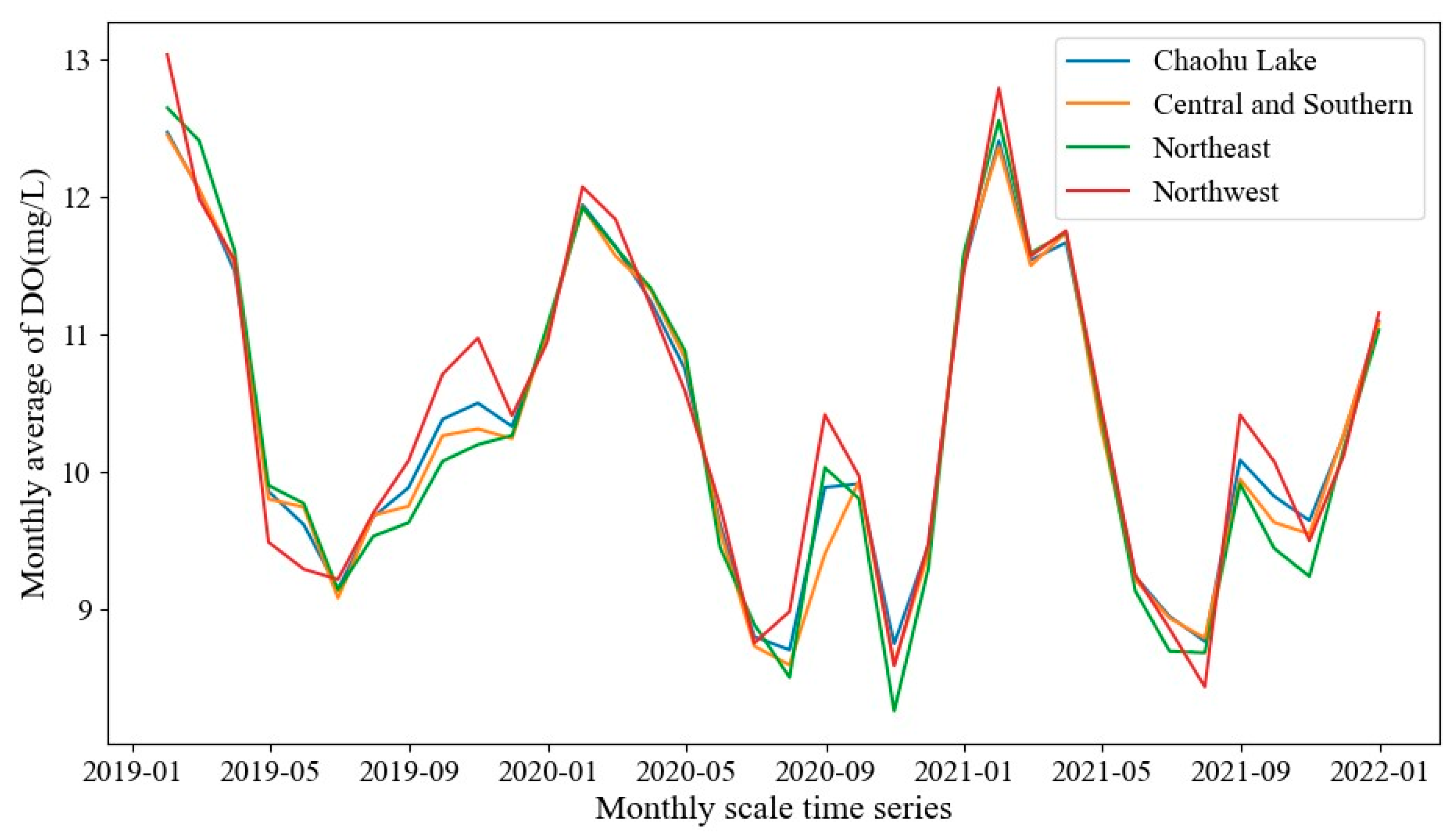2.1.1. Synchronous Satellite Data
The H8 satellite is equipped with the Advanced Himawari Imager (AHI) [
26], which includes 3 visible bands, 3 near-infrared bands, and 10 infrared bands. It captures images of the entire Earth disk every 10 min, covering the Asia-Pacific region, including Asia, Oceania, and parts of the Pacific Ocean. The coverage area is approximately half of the Earth, equivalent to around 3.9 million square miles. It provides high levels of spatial coverage and high temporal resolution. The H8 satellite data used in this study were obtained from the Himawari Monitor
p-free system (
https://www.eorc.jaxa.jp/ptree/, accessed on 15 July 2022), with a spatial resolution of 2 km. Data from 1 January 2019 to 31 December 2021 were selected, and hourly sampling was performed to match the temporal resolution of the measured DO data. A total of 26,258 images were obtained. Channels 1 to 16 were used for DO inversion, with channels 1–6 mainly used for obtaining visible and infrared images to monitor surface clouds, atmospheric details, temperature, and weather patterns, and channels 7–16 mainly used for infrared temperature detection and high-resolution infrared images to detect atmospheric temperature, water vapor distribution, and cloud features and properties, as well as cloud and surface temperature distribution. The roles of each channel are shown in
Table 1.
The obtained H8 data are at Level 1, and direct use may introduce errors. L1-level data constitutes the first stage in meteorological remote sensing data processing, primarily involving observational data acquired from satellite sensors through a series of preprocessing steps to render them suitable for meteorological analysis and applications. The H8 satellite carries multiple sensors, including visible and infrared sensors, to capture imagery across different spectral bands. These sensors measure radiation emanating from Earth’s atmosphere, enabling the retrieval of meteorological information. Raw data obtained from sensors includes noise and other interferences, necessitating preprocessing steps to eliminate these disturbances. This may involve removal of faulty pixels (such as bad points), calibration of radiometric units, temperature correction, and other measures to ensure data accuracy and consistency. In the process of Earth calibration, raw radiance data is transformed into surface reflectance or brightness temperature. This transformation is achieved by comparison with known radiative sources, ensuring the accuracy of measurement outcomes. The data need to be georeferenced to correspond to actual geographical locations on Earth’s surface, requiring geolocation. This involves mapping pixel coordinates to geographic coordinates for correct visualization on maps. Cloud cover in meteorological images can obstruct observations of the Earth’s surface. In L1-level processing, techniques may be applied to detect and remove clouds, enhancing the depiction of surface information.
L1-level data is typically stored in standardized formats for subsequent analysis and applications. This may involve specific image formats, such as Network Common Data Form (NetCDF), or other formats suitable for meteorological data. The format employed in this study is NetCDF. In essence, the H8 satellite’s L1-level data constitutes a series of preprocessed and corrected raw observation data, pivotal for generating high-quality meteorological imagery, monitoring weather changes, and conducting meteorological analysis. At this stage, the data primarily focuses on obtaining accurate radiative information and applying basic image enhancement techniques to facilitate better understanding and utilization of the data. Therefore, atmospheric and orthorectification corrections are necessary. The required remote sensing data were extracted from the orthorectified data by finding the pixel coordinates of the monitoring sections.
When utilizing H8 satellite data, we employed the Py6S model [
27] for atmospheric correction. This model utilizes atmospheric radiative transfer simulations and is based on configured atmospheric parameters, including the selection of suitable aerosol types and the specification of atmospheric pressure and water vapor content. The selection of these parameters is grounded in geographical location, season, and specific application contexts. The parameters used were sourced from the European Centre for Medium-Range Weather Forecasts (ECMWF) Copernicus Climate Data Store. Subsequently, we proceeded by iteratively traversing each pixel within the dataset. For every pixel, we acquired its original reflectance value, and then performed atmospheric correction calculations using the Py6S model, updated with the determined parameters. Based on the model’s apparent radiance output, we converted it into corrected reflectance values and updated the dataset, thereby obtaining more accurate surface reflectance measurements.
Based on Gordon’s original standard near-infrared empirical atmospheric correction algorithm for aquatic remote sensing, the correction is performed by leveraging the unique spectral characteristics of water’s reflectance [
28]. The formula for the model is as follows:
In the equation, represents the remote sensing reflectance of the water body, stands for the apparent reflectance which has undergone atmospheric correction, signifies the atmospheric reflectance, denotes the solar irradiance, and refers to the solar zenith angle.
Finally, the corrected brightness temperature data were converted to surface temperature using Equation (4), and the atmospheric corrected radiance temperature data were converted to brightness temperature using Equations (2) and (3).
where
refers to brightness temperature,
and
are constants,
represents land surface radiance temperature,
represents radiance temperature data after atmospheric correction,
represents land surface temperature,
represents surface temperature,
represents the proportional constant in the TBB band of H8,
represents atmospheric water vapor content, and
represents water vapor pressure.
According to the research by Chen et al. [
29], the Rrs corresponding to solar zenith angles (SOZ) less than 60° is considered to be valid data. Equation (5) is applied to correct the
of bands 1 to 6, in order to mitigate the errors in the reflectance data caused by the offset of SOZ. Based on the threshold proposed by Ning et al. [
22] and Qi et al. [
30], when the
of band 1 is less than or equal to 0.25, the obtained reflectance is generally not affected by solar flicker, thick atmospheric aerosols, and thick cloud cover, and is thus considered to be valid data.
where
i = 1.....6,
represents the
i-th channel of the corrected reflectance,
represents the remote sensing reflectance of the
i-th channel, and
represents SOZ.
For H8′s L1-level data, we initially conducted atmospheric correction using the refined 6S model. Following correction, we applied the Gordon model to perform water body correction on the remote sensing
data. The corrected radiance temperature data were subsequently converted to surface temperature. Using Equations (2) and (3), the atmospherically corrected radiance temperature data were transformed into brightness temperature data. Equation (4) was employed to calculate the surface temperature data. Subsequently, the portion of
corresponding to SOZ of less than 60° was considered to be valid data. Equation (5) was applied to correct the
for bands 1 to 6, and ultimately, data with
≤ 0.25 were deemed valid. The specific flowchart is illustrated in
Figure 1.
2.1.2. DO Data
The measured water quality data used in this study are obtained from the National Surface Water Quality Automatic Monitoring Real-Time Data, which is a comprehensive business portal of the Ministry of Ecology and Environment for the “13th Five-Year Plan” period. The data collection follows the technical specifications of surface water automatic monitoring (HJ 915-2017). The DO data for the Lake Chaohu area from 2019 to 2021 are retrieved. Lake Chaohu (117°17′27.90″~117°50′35.78″ E, 31°42′40.87″~31°25′11.45″ N) is the fifth largest freshwater lake in China, located in the central part of Anhui Province. It has a lake area of approximately 800 km
2 and a shoreline length of 181 km. The maximum water area is about 825 km
2, with a maximum water storage capacity of 4.81 billion m
3 and a maximum depth of 7.98 m. It serves as an important drinking water source for the cities of Hefei and Chaohu, playing a significant role in the economic development and modernization of Anhui Province. According to the “Surface Water Environmental Quality Standards” (GB3838-2002), the overall water quality of Lake Chaohu is classified as Class III, showing eutrophication, excessive levels of total phosphorus and total nitrogen, and frequent occurrences of cyanobacteria blooms. The spatial distribution of the monitoring sections within the Lake Chaohu region is shown in
Figure 2. The monitoring time of the water quality automatic monitoring stations is used as the data annotation time, with a monitoring frequency of 1 h per measurement, and the unit is mg/L. In this study, seven valid monitoring sections with DO measurements are selected based on the coordinates determined in
Section 2.1.1. The information of the monitoring sections is provided in
Table 2.
Since automatic water quality monitoring stations may be influenced by environmental changes or instrument failures during data collection, it is necessary to handle missing and abnormal data to ensure the accuracy of the model’s fitted data. The missing values in the obtained DO data are removed, following the 3σ principle. Concentration data within the range of are retained as the actual DO data used in the model, while data outside this range are considered as abnormal and removed. Here, represents the average DO concentration of the current monitoring section, and represents the standard deviation of the DO concentration of the current monitoring section.
2.1.3. ERA5 Reanalysis Data
ERA5 is the latest global reanalysis dataset of the atmosphere, land surface, and ocean by the ECMWF. It is the successor to ERA-Interim and provides a comprehensive collection of global meteorological, land, and ocean observations from 1979 to the present [
31]. ERA5 incorporates global meteorological, land, and ocean observation data from 1979 to the present. Employing advanced physical processes and data assimilation techniques, ERA5 provides high-quality reanalysis of the atmosphere, land, and ocean. Reanalysis involves the use of modern analysis methods and meteorological models, combined with observational data and historical simulations, to generate a consistent series of historical meteorological data, encompassing various meteorological, land, and oceanic elements such as temperature, wind, precipitation, clouds, land surface temperature, and sea surface temperature. This fills in gaps in observations from the past. The temporal resolution is 1 h per time step, and the spatial resolution is 0.25°.
The ERA5 analysis dataset utilized in this study includes temperature at a height of 2 m, latent heat flux from the surface to the atmosphere, surface pressure, latent heat flux from the atmosphere to the surface, and total precipitation. Temperature in the atmosphere varies with altitude. Near the Earth’s surface, temperature is generally highest, gradually decreasing with increasing altitude. To better understand the actual temperature experienced by humans and surface ecosystems, “2 m temperature” is introduced. It represents the temperature measured at a height of 2 m above the ground. This is a reasonable choice, as at this height, temperature typically closely reflects the actual air temperature experienced by people. The latent heat flux from the surface to the atmosphere is an important concept described in meteorology and Earth science. It quantifies the heat released or absorbed during water phase transitions. Specifically, it refers to the heat released when water evaporates from a liquid state (such as surface water bodies or soil moisture) into water vapor, or the heat absorbed when water vapor condenses into liquid water. Conversely, the latent heat flux from the atmosphere to the surface refers to the heat either released when water vapor condenses into liquid water in the atmosphere or absorbed when water vapor falls to the surface and evaporates. Surface pressure refers to the atmospheric pressure at the Earth’s surface, and is often used to indicate the atmospheric pressure exerted on the Earth’s surface. Surface pressure is a crucial parameter in weather and climate research, playing a key role in predicting weather, analyzing meteorological phenomena, and studying atmospheric motions. Total precipitation refers to the accumulated amount of precipitation in a specific area over a given time period. The ERA5 reanalysis data used in this study was downloaded from
https://cds.climate.copernicus.eu/cdsapp#!/dataset/reanalysis-era5-land?tab=form (accessed on 25 August 2022), in the format of NetCDF files.
